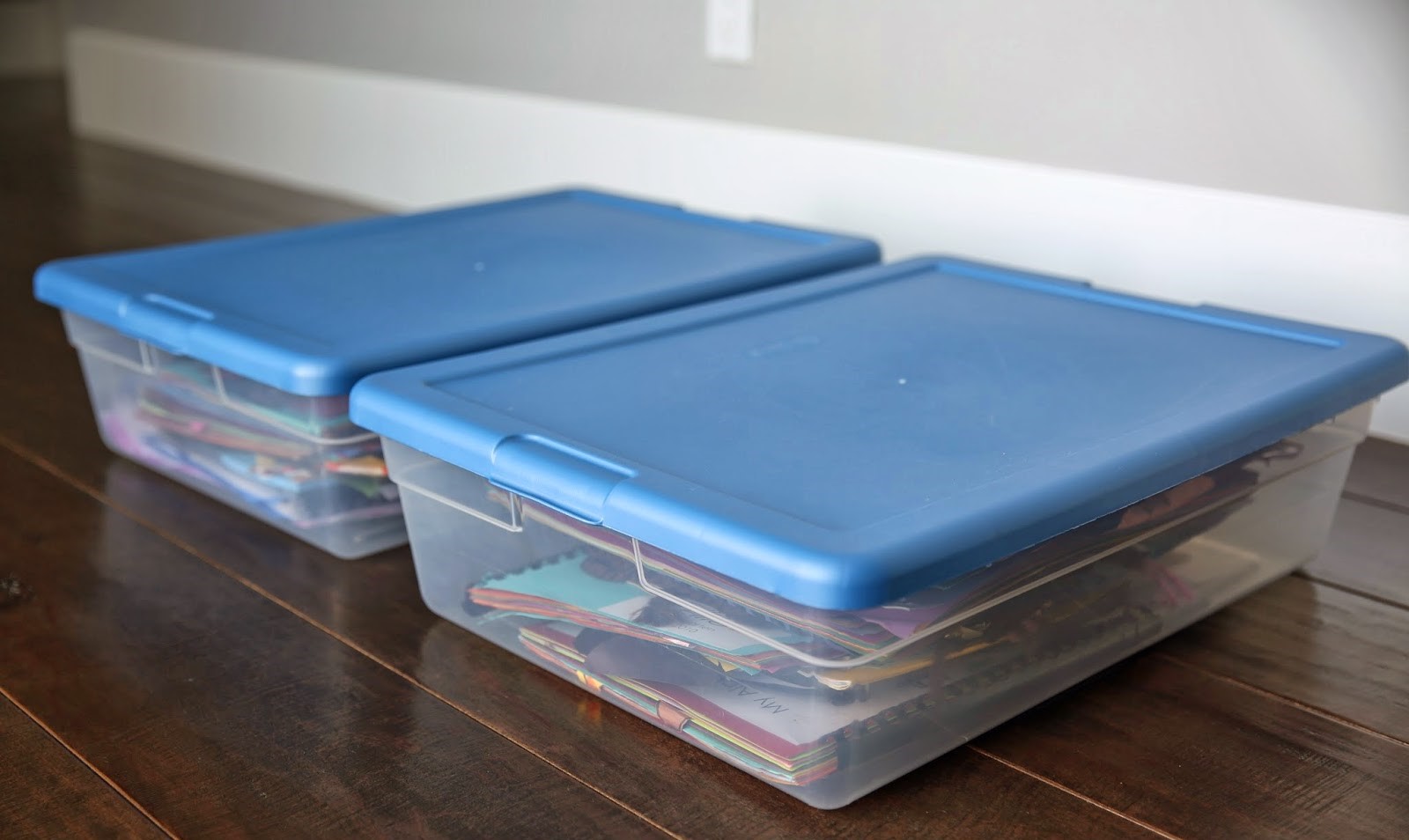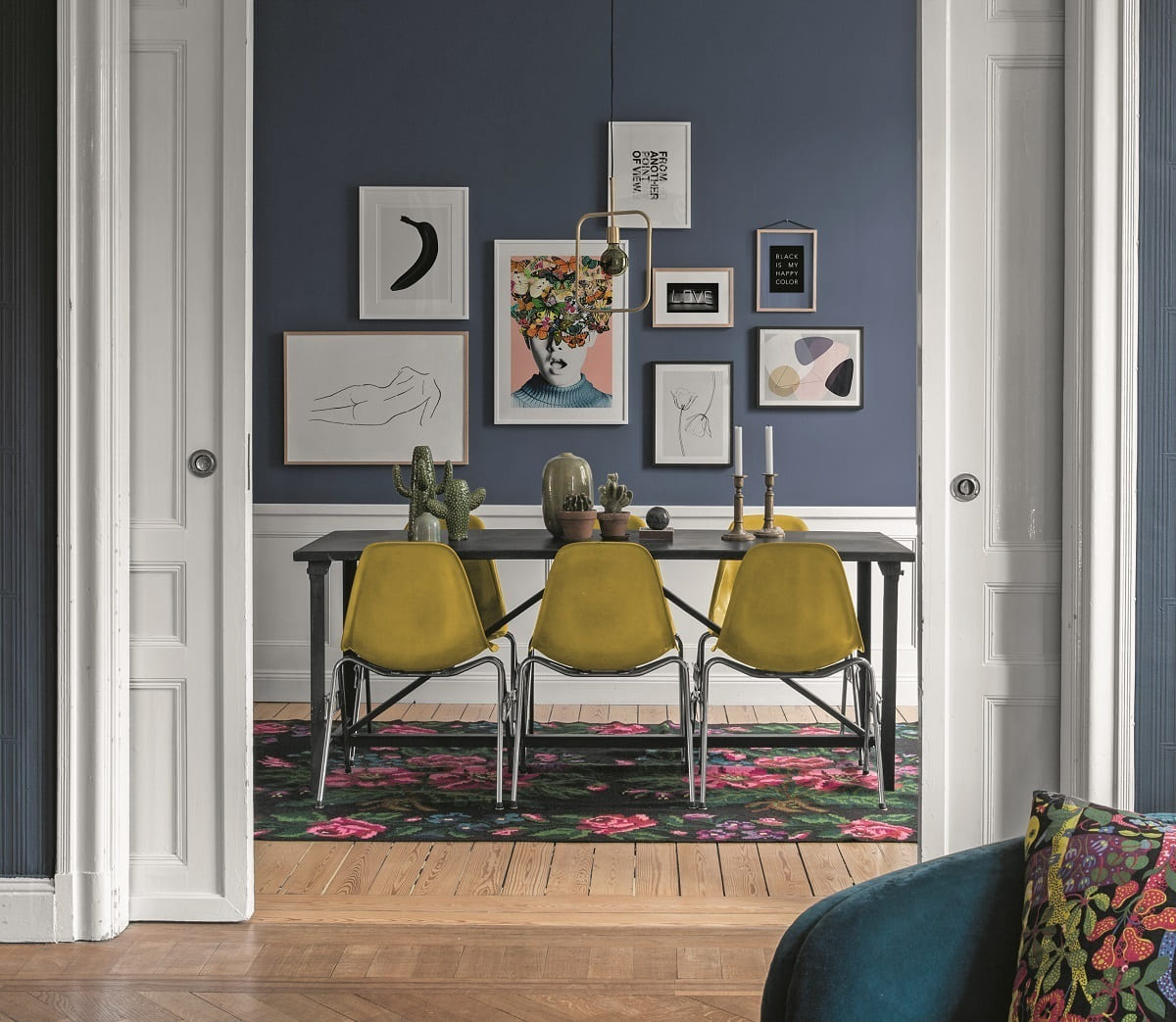

Articles
How To Store Artwork
Modified: January 20, 2024
Learn the best techniques for storing artwork and preserving your valuable articles. Safeguard your collection with these expert tips and tricks.
(Many of the links in this article redirect to a specific reviewed product. Your purchase of these products through affiliate links helps to generate commission for Storables.com, at no extra cost. Learn more)
Introduction
Welcome to the world of art, where creativity and expression come alive on canvas, paper, and various other mediums. As an art enthusiast or collector, you understand the importance of protecting and preserving your artwork. Proper storage plays a crucial role in maintaining the integrity and longevity of your cherished pieces, ensuring they can be enjoyed for generations to come.
Storing artwork may seem like a straightforward task, but there are several factors to consider to ensure your pieces remain in optimal condition. From choosing the right storage space to using the appropriate packing materials, each step is essential in safeguarding your investment.
In this article, we will guide you through the process of storing artwork, covering various types of artworks and providing useful tips for their preservation. By the end of this article, you will have a comprehensive understanding of how to store your artwork properly, giving you peace of mind and confidence in the security of your collection.
Key Takeaways:
- Proper storage of artwork is crucial for preserving its beauty, value, and longevity. By following the guidelines and tips outlined in this article, you can ensure the protection and preservation of your valuable pieces.
- Managing temperature and humidity, protecting artwork from light damage, implementing pest control measures, and prioritizing insurance coverage and security are essential steps in safeguarding your artwork from potential risks.
Read more: How To Store Artwork
Importance of Proper Artwork Storage
Proper artwork storage is vital for preserving the quality, value, and longevity of your art collection. Without the right storage conditions, artwork is susceptible to various types of damage, including fading, warping, mold, pests, and physical deterioration. Here are some key reasons why proper artwork storage is essential:
- Prolonged Lifespan: Artwork is susceptible to environmental factors such as light exposure, temperature fluctuations, humidity levels, and pests. By storing your artwork in optimal conditions, you can significantly prolong its lifespan and prevent irreversible damage.
- Preserving Value: Artwork, especially those created by renowned artists or with historical significance, can be valuable investments. Proper storage helps preserve their value, ensuring that the artwork remains in excellent condition for potential future sale or exhibition.
- Protecting Aesthetic Quality: Artwork is meant to be enjoyed visually. Without proper storage, the colors can fade, the paper or canvas can become brittle, and the overall aesthetic quality can diminish. Adequate storage conditions help maintain the visual appeal and integrity of the artwork.
- Avoiding Damage: Artwork is delicate and sensitive to its surroundings. Without proper storage, it is vulnerable to physical damage, such as scratches, dents, or tears. Additionally, improper storage can lead to chemical reactions, causing paint or ink to deteriorate, resulting in irreversible damage to the artwork.
When it comes to artwork storage, prevention is key. By proactively taking steps to protect your artwork, you can minimize the risk of damage and ensure that your collection remains in pristine condition. In the following sections, we will explore the essential factors to consider when storing artwork, providing you with the knowledge to safeguard your precious pieces.
Factors to Consider Before Storing Artwork
Before you begin the process of storing your artwork, there are several factors to consider to ensure that you create the optimal storage environment. Here are some crucial factors to keep in mind:
- Type of Artwork: Different types of artwork require specific storage considerations. Paintings, drawings, sculptures, textiles, photographs, and mixed media pieces each have their unique requirements. Understanding the specific needs of your artwork will help you determine the most suitable storage methods.
- Size and Dimensions: Take into account the size and dimensions of your artwork when selecting the storage space. Ensure that you have enough room to accommodate the pieces comfortably and without placing stress on them.
- Storage Duration: Consider the length of time you plan to store your artwork. If it’s for a short period, you may opt for temporary storage solutions. For long-term storage, you’ll need to choose more permanent storage options to maintain the integrity of the artworks.
- Access Needs: Determine whether you will require frequent access to your artwork or if it will be stored for extended periods without being retrieved. This will impact the storage methods and organization of your collection.
- Budget: Establish a budget for artwork storage. This will help you determine the options available to you, such as professional art storage facilities, art cabinets, or DIY storage solutions.
- Location: Consider the location of your storage space. Ideally, it should be a clean, dry, and well-ventilated area. Avoid storing your artwork in basements, attics, or areas prone to water leaks, temperature extremes, or high humidity levels.
- Security: Assess the security measures in place to protect your artwork. If you’re storing valuable or irreplaceable pieces, you may want to invest in a storage space with enhanced security features, such as surveillance systems, alarms, and restricted access.
By taking these factors into consideration, you can make informed decisions about the storage options that best suit your artwork’s needs. In the next sections, we will delve deeper into the specific storage methods for different types of artwork, providing you with valuable tips to ensure the preservation of your collection.
Choosing the Right Storage Space
Choosing the right storage space for your artwork is crucial in maintaining its condition and preserving its value. Here are some factors to consider when selecting a storage space:
- Climate Control: Ideally, the storage space should have climate control capabilities to regulate temperature and humidity levels. Fluctuations in temperature and humidity can cause irreversible damage to your artwork, leading to warping, mold growth, or cracking. It is recommended to maintain a temperature between 65-75°F (18-24°C) and a relative humidity level of around 45-55%.
- Clean and Pest-Free Environment: Ensure that the storage space is clean, free from dust, and well-maintained. You should also take measures to prevent any pest infestations, as insects and rodents can cause significant damage to your artwork.
- Security Measures: Consider the security measures in place to protect your artwork. Look for storage spaces with reliable locking systems, surveillance cameras, and restricted access. If you’re storing valuable or irreplaceable pieces, you may also want to opt for storage spaces that offer additional security features, such as alarm systems or on-site security personnel.
- Lighting Conditions: Avoid storing artwork in areas with direct sunlight or harsh artificial lighting. Exposure to light can cause fading and deterioration of colors over time. If the storage space has windows, consider using UV-filtering film or shades to block out harmful UV rays.
- Ventilation: Proper ventilation is essential to prevent the buildup of moisture and mold. Ensure that the storage space has adequate airflow to keep humidity levels in check.
- Space and Accessibility: Consider the available space and how it can accommodate your artwork. Ensure there is enough room to store your pieces without overcrowding or stacking them excessively, as this can lead to damage. Additionally, consider how easy it is to access your artwork when needed, especially if you anticipate frequent retrieval.
Depending on your specific needs and budget, you have several options for storage spaces. These can range from specialized art storage facilities that offer climate-controlled rooms and enhanced security features to more budget-friendly alternatives, such as renting a storage unit or repurposing a dedicated room in your home. Remember to weigh the pros and cons of each option to ensure you find the best storage space for your artwork.
By selecting the right storage space, you provide a suitable environment for your artwork, reducing the risk of damage and ensuring its long-term preservation. In the following sections, we will delve into the proper preparation and packing methods for different types of artwork, providing you with valuable insights to properly store your collection.
Preparing Artwork for Storage
Before storing your artwork, it is crucial to properly prepare it to ensure its safety and preservation. Here are some essential steps to take when preparing your artwork for storage:
- Clean the Artwork: Begin by gently cleaning the artwork to remove any dust or dirt. Use a soft, lint-free cloth or a clean brush to carefully wipe the surface. Be cautious not to apply excessive pressure or use harsh cleaning agents, as this can damage the artwork.
- Inspect for Damage: Thoroughly examine your artwork for any signs of damage, such as tears, loose elements, or flaking paint. If you notice any issues, consider getting the artwork repaired or restored before storing it to prevent further deterioration.
- Document the Artwork: It is vital to document each piece of artwork before storing it. Take detailed photographs, including close-ups of any distinguishing features or damage. This documentation will serve as a reference for insurance purposes and help track the condition of your collection over time.
- Remove Unnecessary Accessories: Remove any unnecessary accessories, such as frames, matting, or glass covers, before storing framed artwork. This reduces the risk of damage during storage and allows for more efficient packing.
- Protect Fragile Elements: If your artwork contains fragile elements, such as protruding elements or textured surfaces, take extra precautions to protect them during storage. Cover these areas with acid-free tissue paper or protective padding to prevent any accidental damage.
- Consider Conservation Materials: Use acid-free, archival-quality materials whenever possible. Acid-free tissue paper, foam boards, and acid-free plastic sleeves or bags provide an extra layer of protection against acidic materials that can deteriorate artwork over time.
- Label Artwork: Label each artwork with essential information, including the artist’s name, title, date, and any other relevant details. This labeling ensures easy identification and helps maintain accurate records of your collection.
- Organize and Inventory: Develop a system to keep track of your stored artworks. Create an inventory list or use digital asset management software to document and organize your collection. This will make it easier to locate specific artworks when needed and keep a record of their condition and storage location.
By properly preparing your artwork before storage, you minimize the risk of damage and ensure its preservation. Taking the time to clean, inspect, and document your artwork will help maintain its condition and provide you with peace of mind when storing your valuable collection. In the next sections, we will explore the appropriate packing materials and methods for different types of artwork, ensuring their safekeeping during storage.
Read more: How To Store Children’S Artwork
Proper Packing Materials for Artwork
When it comes to storing artwork, using the right packing materials is essential to protect your pieces from damage. Here are some recommended packing materials for different types of artwork:
- Acid-free Tissue Paper: Use acid-free tissue paper to wrap delicate or sensitive surfaces of artwork. It provides a protective layer between the artwork and any additional packaging materials, preventing potential damage caused by direct contact.
- Bubble Wrap: Bubble wrap is an excellent material for providing cushioning and shock absorption. Wrap fragile artwork, such as paintings or sculptures, in several layers of bubble wrap to protect them from impacts during storage or movement.
- Cardboard Corner Protectors: For framed artwork, use cardboard corner protectors to prevent the corners of frames from getting damaged or dented. They provide extra reinforcement and support during storage or transportation.
- Archival Storage Boxes: Archival storage boxes are ideal for protecting flat artwork, such as drawings, prints, or photographs. Choose acid-free and lignin-free boxes to prevent any acidic components from interacting with and damaging the artwork. Place acid-free tissue paper between each piece to prevent scratching or sticking.
- Portfolio Cases: Portfolio cases are suitable for storing and protecting larger artworks, such as oversized drawings or paintings. Look for cases made of acid-free and waterproof materials to ensure proper preservation.
- Cardboard Tubes: Use sturdy cardboard tubes for storing rolled-up artworks, such as posters, prints, or canvases. Make sure the tubes are acid-free and have adjustable end caps to secure the artwork tightly.
- Glassine Sheets: Glassine sheets are ideal for protecting delicate or sensitive surfaces, such as charcoal or pastel drawings. Place a sheet of glassine paper between each artwork to prevent smudging or transfer of media.
- Foam Board: Foam boards provide sturdy backing for artworks during storage or transportation. Use them to support framed or mounted artwork and protect them from bending or warping.
Remember to always handle artwork with clean hands and wear gloves when necessary to avoid leaving fingerprints or oils on the surface. Additionally, make sure the packing materials fit the artwork snugly but are not too tight to prevent damage during storage.
By using the appropriate packing materials, you provide an extra layer of protection and help ensure the safety of your artwork during storage. In the upcoming sections, we will explore different storage methods and specific tips for storing framed, unframed, 3D, textile, and paper artwork to help you maintain their condition and preserve their beauty.
Methods for Storing Artwork
There are various methods for storing artwork, depending on the type, size, and specific needs of each piece. Here, we will explore different storage methods for various types of artwork:
- Framed Artwork: Store framed artwork vertically, if possible, to prevent warping or distortion. If you need to stack framed artwork, place soft padding or foam sheets between each piece to provide cushioning and protect against scratches or impact. For added protection, consider wrapping framed artwork in acid-free plastic sleeves or bags before storage.
- Unframed Artwork: Unframed artwork, such as paintings on canvases or works on paper, can be stored flat or rolled, depending on its size and condition. If storing flat, use acid-free storage boxes or portfolio cases with acid-free tissue paper between each piece to prevent damage. For rolled artwork, use sturdy cardboard tubes with adjustable end caps and wrap the artwork with acid-free tissue paper before rolling.
- Sculptures and 3D Artwork: When storing sculptures or three-dimensional artwork, each piece should be individually wrapped to prevent scratching or damage. Use a combination of bubble wrap, foam padding, and soft cloth to provide cushioning and protection. If possible, store sculptures in separate boxes or containers to avoid any potential contact or damage from shifting during storage.
- Textile and Fabric Artwork: Textile and fabric artwork, such as tapestries, quilts, or embroidery, should be stored in a dry and clean environment to prevent mold or mildew growth. Before storage, ensure the artwork is fully dry and clean. Roll the textile with acid-free tissue paper to support it and place it in an acid-free storage tube or wrap it in a clean, breathable fabric. Avoid folding the textile, as this can lead to permanent creases or damage.
- Photograph and Paper Artwork: Photographs and paper artwork are sensitive to light, moisture, and temperature fluctuations, so it is crucial to store them in archival-quality materials. Use acid-free storage boxes or sleeves, ensuring that the artwork is fully supported and protected from bending or tearing. Store them in a cool, dry, and dark environment to prevent damage from light exposure and humidity.
Whatever method you choose, always ensure that the storage area is clean, dry, and well-ventilated. Avoid storing artwork in areas prone to temperature extremes, high humidity levels, or direct sunlight. Regularly inspect your storage area and artwork to identify any potential issues or signs of damage.
By following these storage methods, you can ensure the proper preservation of your artwork and protect it from potential damage during storage. In the upcoming sections, we will provide specific tips for storing different types of artwork, including framed artwork, unframed artwork, sculptures, textiles, photographs, and paper artwork.
Framed Artwork Storage Tips
When it comes to storing framed artwork, careful handling and proper storage techniques are essential to ensure its protection. Here are some valuable tips to consider when storing framed artwork:
- Cleaning: Before storing, make sure to clean the glass or acrylic surface of the frame with a non-abrasive cleaner and a soft, lint-free cloth. This will remove any dust or fingerprints that could potentially damage the artwork during storage.
- Remove Hanging Hardware: Take out any hanging hardware, such as nails or hooks, from the back of the frame. This prevents them from causing damage or scratching other artworks during storage.
- Protective Cover: Consider placing a sheet of acid-free glassine paper or a clean, soft cloth between the artwork and the glass surface. This additional layer will help prevent any sticking or damage that may occur due to humidity or temperature changes.
- Wrap with Bubble Wrap: Wrap the framed artwork with several layers of bubble wrap to provide cushioning and protect it from impacts or pressure. Ensure that all edges and corners are well-protected to prevent any damage while in storage.
- Vertical Storage: Whenever possible, store framed artwork vertically rather than horizontally. Vertical storage helps prevent warping or distortion of the frame and ensures a more secure and stable position.
- Padding between Artworks: If you need to stack framed artwork, place soft padding such as foam sheets or acid-free cardboard between each piece to create a buffer and prevent any potential scratching or pressure damage.
- Avoid Extreme Temperatures: It is best to store framed artworks in an environment with a consistent temperature. Avoid storing them in areas that are prone to extreme temperature fluctuations or high humidity levels, as this can damage the artwork over time.
- Secure Storage: Store the framed artworks in a secure location to prevent any potential unauthorized access or accidental damage. Consider using a locked storage area or investing in a professional art storage facility for added security.
By following these framed artwork storage tips, you can ensure the protection of your valuable pieces and maintain their condition. In the next sections, we will provide storage tips for unframed artwork, sculptures, textiles, photographs, and paper artwork.
Unframed Artwork Storage Tips
Storing unframed artwork requires careful handling and appropriate storage methods to ensure its preservation and protection. Here are some valuable tips to consider when storing unframed artwork:
- Clean and Dry: Ensure that the unframed artwork is clean and dry before storing it. Any dirt or moisture can lead to damage or mold growth over time. If needed, gently clean the artwork using a soft, lint-free cloth or brush.
- Supportive Backing: If the unframed artwork is on paper or a delicate material, ensure it has a supportive backing such as acid-free foam board or archival matting. This will help prevent any creasing or bending during storage.
- Avoid Folding: Never fold unframed artworks, as this can cause permanent creases or damage. Instead, store them flat or rolled, depending on the size and fragility of the artwork.
- Flat Storage: For smaller unframed artworks, store them flat in acid-free archival folders or boxes. Place acid-free tissue paper between each piece to prevent scratching or sticking. Label each folder or box for easy identification.
- Rolled Storage: For larger unframed artwork, consider rolling them carefully. Use an acid-free tissue paper or protective film to wrap the artwork before rolling it. Place the rolled artwork inside a sturdy cardboard tube with adjustable end caps to secure it in place.
- Protect from Light: Store unframed artwork away from direct sunlight or harsh lighting to prevent fading and discoloration. Ultraviolet (UV) radiation can cause irreversible damage to the artwork over time.
- Avoid Extreme Conditions: Keep unframed artwork stored in a cool, dry environment with stable temperature and humidity levels. Avoid areas prone to fluctuations in temperature or high humidity, as this can lead to moisture damage or mold growth.
- Organize and Archive: Establish a system for organizing and archiving your unframed artwork. Label each piece with essential information such as the artist’s name, title, date, and medium. Use digital asset management software or cataloging systems to keep track of your collection.
By following these unframed artwork storage tips, you can ensure the protection and preservation of your valuable pieces. In the next sections, we will provide storage tips for sculptures, textiles, photographs, and paper artwork to help you maintain the condition of your collection.
When storing artwork, use acid-free materials to protect against deterioration. Store in a cool, dry place away from direct sunlight and fluctuations in temperature and humidity.
Read more: How To Store Kids Artwork
Sculpture and 3D Artwork Storage Tips
Proper storage of sculptures and three-dimensional (3D) artwork is vital to ensure their protection and preservation. These pieces require special consideration due to their fragility and unique dimensions. Here are some valuable tips for storing sculpture and 3D artwork:
- Individual Packaging: Wrap each sculpture or 3D artwork individually with soft, acid-free tissue paper or bubble wrap. This will provide cushioning and protect delicate and protruding elements from damage or breakage.
- Sturdy Containers: Place each wrapped sculpture in a dedicated, sturdy container or box. Use acid-free archival boxes or specialized containers designed for artwork storage. Ensure that the container is the appropriate size to prevent excessive movement during storage.
- Inner Support: If the sculpture has moveable parts or fragile elements, use archival foam or soft padding to support them. This helps to prevent stress or movement that can lead to damage during storage or transportation.
- Labeling and Documentation: Clearly label each container or box with detailed information about the sculpture, including the artist’s name, title, and any special handling instructions. Make sure to document the condition of each piece through photographs or written records for reference.
- Proper Positioning: Store sculptures in an upright position whenever possible to avoid warping or distortion. If upright storage is not feasible, carefully lay the sculpture on a stable surface, ensuring that delicate elements are well-protected and supported to prevent damage.
- Avoid Direct Contact: To avoid scratches or damage, never allow sculptures to come into direct contact with each other during storage. Create a barrier between sculptures using soft padding or archival foam sheets.
- Climate Control: Maintain a consistent temperature and humidity level within the storage area. Extreme temperature fluctuations and high humidity can cause irreversible damage to sculptures and 3D artwork. Aim for a temperature of around 65-75°F (18-24°C) and a relative humidity level of about 45-55%.
- Secure Storage Area: Store sculptures in a clean, secure, and well-ventilated area. Choose a location that is free from pests, excessive dust, and potential hazards. Consider using a locked storage room or a professional art storage facility for enhanced security.
By following these sculpture and 3D artwork storage tips, you can help ensure the protection and preservation of these unique and valuable pieces. In the upcoming sections, we will provide storage tips for textiles, photographs, and paper artwork to help you maintain the condition of your collection.
Textile and Fabric Artwork Storage Tips
Textile and fabric artwork, such as tapestries, quilts, or embroideries, require specialized care and storage techniques to preserve their beauty and integrity. Follow these textile and fabric artwork storage tips to ensure their long-term protection:
- Clean and Dry: Before storing textile artwork, make sure it is clean and dry. Any dirt or moisture can lead to staining, mold growth, or deterioration over time. If needed, gently clean the textile according to the manufacturer’s instructions or seek professional conservation assistance.
- Supportive Structure: Textile artwork should be stored on a supportive structure, such as an acid-free foam board or archival-quality mount, to provide rigidity and minimize the risk of creasing or warping.
- Avoid Folding: Never fold textile artwork, as this can lead to permanent creases and damage the fibers. Instead, store them flat or roll them depending on the size and fragility of the textile. Larger pieces may need to be rolled for storage.
- Acid-Free Tissue Paper: Place sheets of acid-free tissue paper between folded areas or layers of textile artwork to provide cushioning and prevent sticking. Acid-free tissue paper is essential to avoid any acidic interaction that can damage the fabric over time.
- Rolling Technique: To store large or delicate textile artwork, carefully roll it on a sturdy tube. Use acid-free tissue paper or fabric to protect the surface of the textile and place acid-free cardboard tubes at both ends of the roll for support.
- Protective Covering: Consider covering textile artwork with a clean, breathable fabric or acid-free tissue paper to protect it from dust and potential light exposure. Avoid using plastic coverings, as they can trap moisture and promote mold growth.
- Climate Control: Store textile artwork in a cool, dry environment with stable temperature and humidity levels. Excessive heat or humidity can lead to mold, mildew, or insect infestation. Aim for a temperature around 65-75°F (18-24°C) and a relative humidity level of about 45-55%.
- Protect from Light: Textile artwork is sensitive to light, especially ultraviolet (UV) radiation, which can cause fading and deterioration. Store textile pieces away from direct sunlight or harsh artificial lighting to preserve their colors and fibers.
- Inspection: Regularly inspect textile artwork stored for signs of damage, including pest infestation, mold growth, or discoloration. If any issues are detected, address them promptly to prevent further damage.
By following these textile and fabric artwork storage tips, you can help ensure the preservation of these delicate and valuable pieces. In the next sections, we will provide storage tips for photographs and paper artwork to complete your knowledge on storing various types of artwork.
Photograph and Paper Artwork Storage Tips
Proper storage of photographs and paper artwork is crucial in preserving their condition and ensuring their longevity. Follow these storage tips to protect your valuable photographs and paper artwork:
- Clean and Dry: Ensure that photographs and paper artwork are clean and dry before storing them. Remove any dust or debris using a soft, lint-free cloth or a bristle brush. Avoid exposing them to moisture, which can cause damage such as warping or mold growth.
- Archival Materials: Use acid-free and lignin-free storage materials, such as archival-quality folders, sleeves, and boxes. These materials are specially designed to protect photographs and paper artwork from deteriorating due to chemical reactions over time.
- Handling with Care: Always handle photographs and paper artwork with clean, dry hands or wear cotton gloves to avoid transferring oils, dirt, or moisture onto the delicate surfaces. Hold them by the edges to minimize contact with the image or artwork itself.
- Flat Storage: Store photographs and flat paper artwork in acid-free archival folders or sleeves. Place acid-free tissue paper between each piece to prevent sticking or abrasion. Label each folder or sleeve for easy identification.
- Mounting Options: Consider using acid-free photo corners, archival mounting tape, or hinges to secure photographs or paper artwork onto acid-free mats or boards. This allows for easy removal and prevents any adhesives from directly touching the artwork.
- Avoid Direct Light Exposure: Protect photographs and paper artwork from excessive exposure to light, especially ultraviolet (UV) radiation. UV rays can cause fading and deterioration over time. Store them in a dark or low-light environment or use UV-filtering glass or sleeves for display purposes.
- Climate Control: Maintain a stable environment with controlled temperature and humidity levels. Fluctuations in temperature and high humidity can cause damage to photographs and paper, leading to curling, warping, or mold growth. Aim for a temperature between 65-75°F (18-24°C) and a relative humidity level of around 45-55%.
- Secure Storage: Store photographs and paper artwork in a clean, dry, and secure area. Avoid damp or humid spaces prone to water leaks and pests. Consider using a locked cabinet, acid-free storage boxes, or professional storage facilities with environmental controls for added security.
- Regular Inspection: Periodically inspect stored photographs and paper artwork for any signs of deterioration, such as discoloration, mold, or pests. Early detection allows for prompt intervention to mitigate further damage or deterioration.
Following these storage tips will help protect your valuable photographs and paper artwork from damage and ensure their preservation for years to come. Remember to handle and store them with care to maintain their quality and integrity. With proper storage techniques, you can enjoy and share these treasured pieces for generations.
Managing Temperature and Humidity
Proper temperature and humidity management are critical for the preservation of artwork, as fluctuations in these factors can cause irreversible damage. Here are some guidelines for managing temperature and humidity when storing artwork:
- Temperature Control: Aim to maintain a consistent temperature within the storage area. Fluctuations in temperature can cause expansion and contraction, leading to warping, cracking, or other forms of damage. Ideally, the temperature should be between 65-75°F (18-24°C).
- Humidity Control: High humidity levels can promote mold growth and accelerate deterioration, while low humidity can cause papers and textiles to become brittle. Aim for a relative humidity level of around 45-55%. Use a hygrometer to monitor and regulate humidity levels.
- Climate Control Systems: Consider using climate control systems, such as HVAC (heating, ventilation, and air conditioning) systems, dehumidifiers, or humidifiers to regulate temperature and humidity levels in the storage area. These systems help maintain a stable environment for artwork preservation.
- Insulation: Ensure that the storage area is properly insulated to minimize the impact of external temperature changes. Proper insulation helps maintain a more stable internal environment, reducing the risk of sudden temperature fluctuations.
- Seal Windows and Doors: Seal any gaps around windows and doors to minimize the exchange of air between the storage area and the exterior environment. This helps to maintain more consistent temperature and humidity levels within the storage space.
- Avoid Damp Areas: Keep artwork away from areas prone to water leaks or high humidity, such as basements or areas near plumbing. Moisture can cause severe damage to artwork, including mold growth, warping, and deterioration.
- Use Desiccants: Desiccant packets or containers can help absorb excess moisture in the storage area. Place them strategically within the storage space, ensuring they do not directly touch the artwork, to help maintain optimal humidity levels.
- Regular Monitoring: Regularly monitor temperature and humidity levels in the storage area. Keep a log of readings over time to identify any patterns or significant fluctuations. This helps to detect and address any issues promptly.
- Professional Storage Facilities: If you have valuable or sensitive artwork, consider utilizing professional storage facilities equipped with climate-control systems. These facilities offer specific zones with controlled temperature and humidity levels to ensure the preservation of artwork.
By effectively managing temperature and humidity, you can create an environment that safeguards your artwork from damage caused by fluctuations in these factors. The stability of temperature and humidity levels is crucial in preserving the integrity and longevity of your valuable pieces. In the next sections, we will explore tips for protecting artwork from light damage and implementing pest control measures.
Read more: How To Store Framed Artwork
Protecting Artwork from Light Damage
Exposure to light, particularly ultraviolet (UV) radiation, can cause significant damage to artwork over time. To protect your artwork from light damage, follow these important guidelines:
- Avoid Direct Sunlight: Keep artwork away from direct sunlight or intense artificial lighting. Sunlight contains high levels of UV radiation that can fade colors, bleach paper, and cause deterioration of materials.
- Display in Low Light: When displaying artwork, choose areas with low levels of ambient light. Use curtains, blinds, or UV-filtering window films to block or reduce sunlight. Install low-intensity, non-UV emitting light fixtures for proper illumination.
- UV-Filtering Glass: If you choose to frame and display artwork, opt for UV-filtering glass or acrylic. These materials block most harmful UV rays while still allowing the artwork to be seen. Ensure that the glass or acrylic is properly sealed within the frame to maintain its effectiveness.
- Matting: Use acid-free mats or mount boards to create a barrier between the artwork and the glazing. The matting not only provides an aesthetically pleasing border but also helps to prevent direct contact between the artwork and the glazing, reducing the risk of damage.
- Rotate Artwork: If your artwork is displayed for an extended period, consider periodically rotating the pieces to minimize exposure to light. This allows equal distribution of light exposure, reducing the potential for uneven fading or damage.
- Proper Lighting Duration: Limit the amount of time that artwork is directly exposed to light. Consider using timers or motion sensors to control lighting, ensuring that artwork is illuminated only when necessary, and keeping it in darkness or dim lighting when not in use.
- Secure Transportation: During transportation, protect artwork from direct sunlight by using opaque covers or wrapping it in light-resistant materials. Keep in mind that exposure to sunlight through windows during transit can still cause damage if the artwork is not adequately protected.
- Digital Reproductions: Consider creating digital reproductions of your artwork for public display, online portfolios, or print reproductions. This allows you to share and promote your artwork without the risk of light damage to the original pieces.
- Regular Inspection: Regularly inspect your artwork for signs of fading, color changes, or degradation. Promptly address any issues and consider consulting with a professional conservator for proper restoration or conservation if necessary.
By implementing these protective measures, you can significantly reduce the risk of light damage to your artwork and ensure its long-term preservation. Proper lighting control and UV-filtering materials are crucial in safeguarding the integrity and vibrancy of your valuable pieces. In the next section, we will explore pest control measures to further protect your artwork.
Pest Control Measures
Pests can pose a significant threat to your artwork, causing irreparable damage to paintings, sculptures, textiles, and paper. Implementing effective pest control measures is crucial to protect your valuable pieces. Here are some essential pest control measures to consider:
- Preventative Measures: Regularly inspect your storage area for any signs of pests, such as droppings, shed skins, or chewed materials. Seal any cracks, gaps, or openings to prevent pests from entering the storage space.
- Cleanliness: Keep the storage area clean and well-maintained. Regularly vacuum or sweep the floor and wipe down surfaces to remove any food particles or debris that may attract pests.
- Food and Water Sources: Avoid storing food or beverages in the same area as your artwork. Pests are attracted to food sources, and the presence of food can lead to infestations. Ensure that the storage area is dry, as pests are also attracted to moisture.
- Proper Packaging: Ensure that artwork is properly wrapped and sealed to prevent pests from accessing the artwork. Use sturdy and sealed containers or archival boxes with tight-fitting lids to create a barrier against pests.
- Pest-Resistant Materials: Consider using pest-resistant packaging materials, such as plastic bins or metal storage cabinets, that offer additional protection against pests. Avoid using cardboard boxes, as pests can easily chew through them.
- Chemical-Free Pest Control: Opt for chemical-free pest control methods to avoid potential damage to the artwork. Use natural pest deterrents such as lavender sachets, cedar chips, or herbal repellents, which can help repel pests without harming the artwork.
- Regular Monitoring: Regularly inspect your artwork for any signs of pest activity. Look for droppings, holes, chewed edges, or visible damage. Early detection allows for immediate intervention and minimizes the extent of damage caused by pests.
- Professional Pest Control: If you discover an infestation or suspect a serious pest problem, consult with a professional pest control company specializing in art storage facilities. They can provide targeted pest control treatments without compromising the safety or integrity of your artwork.
- Off-Site Storage Facilities: Consider utilizing professional art storage facilities that have implemented stringent pest control measures. These facilities are designed to protect artwork from a variety of threats, including pests, and provide a controlled environment for its preservation.
By implementing these pest control measures, you can minimize the risk of pests damaging your artwork. Regular monitoring, cleanliness, and proper packaging are key in protecting your valued pieces from infestations. By taking preventive steps and addressing any pest issues promptly, you can ensure the long-term preservation of your artwork. In the concluding section, we will discuss the importance of insurance and security when storing artwork.
Insurance and Security for Artwork Storage
When storing artwork, it is crucial to prioritize insurance coverage and security measures to protect your valuable pieces from potential loss or damage. Here are key considerations for ensuring the safety and security of your stored artwork:
- Artwork Insurance: Obtain appropriate insurance coverage for your artwork. Standard homeowner’s insurance may not fully cover your valuable pieces while in storage. Consult with an insurance provider specializing in art insurance to ensure comprehensive coverage against theft, damage, vandalism, or natural disasters.
- Detailed Inventory: Maintain a detailed inventory of your stored artwork, including photographs, descriptions, provenance, and estimated value. This inventory will serve as crucial documentation for insurance claims and can aid in recovering or identifying stolen artwork.
- Secure Storage Facilities: Choose a reliable storage facility with robust security features, such as 24/7 surveillance cameras, alarms, access controls, and on-site security personnel. These measures deter potential intruders and provide a higher level of protection for your artwork.
- Access Control: Ensure that the storage facility has strict access control protocols in place. Only authorized individuals should have access to the storage area, and records of entry should be maintained for security purposes.
- Fire Prevention and Suppression: Confirm that the storage facility has proper fire prevention and suppression systems in place. This includes smoke detectors, fire alarms, sprinkler systems, and regular maintenance to minimize the risk of fire damage to your artwork.
- Climate Control: Verify that the storage facility provides adequate climate control measures to maintain stable temperature and humidity levels. This ensures optimal conditions for preserving artwork and prevents damage caused by extreme fluctuations in climate.
- Transportation Security: If you need to transport your artwork to and from storage, ensure that secure transportation methods are employed. Use reliable art transport services equipped with specialized vehicles and security protocols to protect artwork during transit.
- Security Checks: Periodically review the security measures implemented by the storage facility. This includes checking the functionality of surveillance systems, verifying access logs, and evaluating the overall security protocol to maintain a high standard of protection.
- Supplementary Security Measures: Consider additional security measures such as security decals, security cages or screens for individual storage units, and unique identifiers on artwork crates to deter theft or unauthorized access.
- Emergency Preparedness: Inquire about the storage facility’s emergency preparedness plans, including procedures for natural disasters, power outages, or other unforeseen events. Understanding these protocols helps ensure the safety and integrity of your stored artwork.
By prioritizing insurance coverage and implementing stringent security measures, you can safeguard your artwork against potential risks. Thorough documentation, secure storage facilities, and reliable transportation methods are vital in providing peace of mind and protecting your valued artwork. With the right precautions in place, you can confidently store your artwork, knowing it is well-protected.
Conclusion
Proper storage of artwork is essential for preserving its beauty, value, and longevity. By following the guidelines and tips outlined in this article, you can ensure the protection and preservation of your valuable pieces. Consider the factors to consider before storing artwork, such as the type of artwork, storage duration, and access needs. Choose a suitable storage space with climate control, proper lighting conditions, and adequate security measures.
Prepare your artwork for storage by cleaning and inspecting each piece, documenting its condition, and using appropriate packaging materials. Depending on the type of artwork, whether it’s framed, unframed, sculpture, textile, or paper, specific storage methods and materials should be applied to ensure their safety.
Managing temperature and humidity is crucial as fluctuations can cause significant damage. Protect your artwork from light damage by avoiding direct sunlight, using UV-filtering materials, and controlling lighting conditions. Implement pest control measures to prevent infestations and regular monitoring to detect and address any issues promptly.
Lastly, prioritize insurance coverage for your artwork and select storage facilities with robust security measures. Maintain detailed inventory records and ensure secure transportation when necessary. By taking these steps, you can mitigate potential risks and protect your artwork from damage, theft, or loss.
Remember, your artwork represents your passion, investment, and creative expression. By implementing the proper storage techniques and prioritizing its protection, you can enjoy and preserve your valuable pieces for years to come. Take the necessary measures to ensure their safety and cherish the beauty they bring to your life and the lives of others.
Frequently Asked Questions about How To Store Artwork
Was this page helpful?
At Storables.com, we guarantee accurate and reliable information. Our content, validated by Expert Board Contributors, is crafted following stringent Editorial Policies. We're committed to providing you with well-researched, expert-backed insights for all your informational needs.













0 thoughts on “How To Store Artwork”